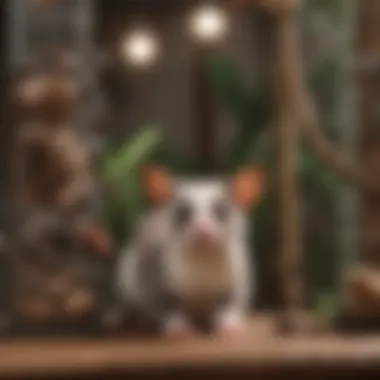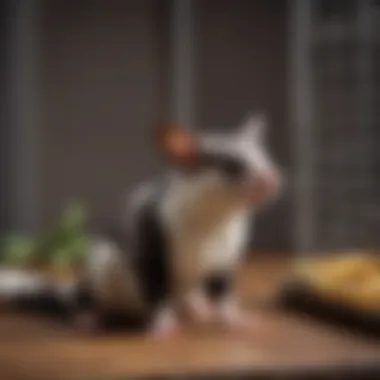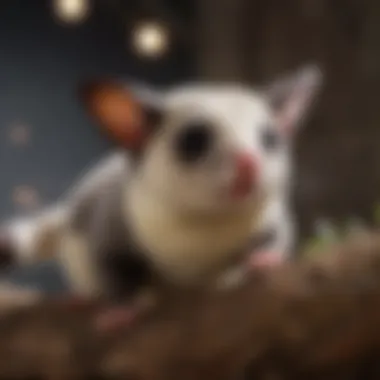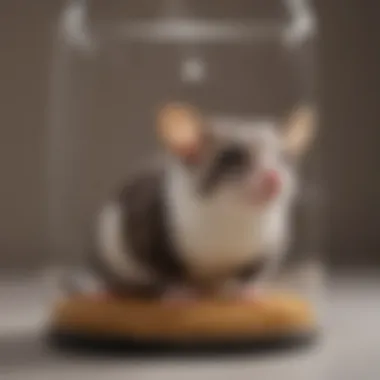Optimal Cage Size for Sugar Gliders: Essential Insights


Intro
Understanding the space needs for sugar gliders is vital for their overall health and happiness. These small marsupials thrive when their environments are optimally designed to mimic their natural habitat. This section will explore crucial points regarding what constitutes the ideal cage size and how various dimensions impact their behavior.
Care Tips
Daily Care Routines
Sugar gliders require consistent care to ensure that they adjust well to their environment. Daily routines should include checking food and water levels, providing fresh fruits and vegetables, and engaging in social interaction. Monitoring their mood and energy levels regularly is also hiring as subtle changes can indicate larger issues.
Cage Setup and Maintenance
The cage serves as their home. An ideal cage size allows ample space for movement and exploration. A minimum of 24 inches in width, and 36 inches in height is recommended, though larger dimensions enhace their freedom to glide and play. Habitat maintenance is equally important; accessories such as perches, ropes, and swings should be cleaned frequently to retain their functional and aesthetic quality.
Hygiene and Cleaning Practices
Regular sanitization prevents illness and promotes a healthy living space. Perform iterations of deep monthly cleaning, focusing on corners where waste may gather. Use disinfectants safe for animals, ensuring to rinse thoroughly afterward. Establish a habit of checking for mold or discoloration on nesting materials, often breeding places for germs.
Seasonal Care Adjustments
Adapting care routines according to the four seasons is also essential. During warmer months, maintain ambient temperatures conducive to their comfort, potentially introducing fans for better airflow. Cold weather often requires adjustments in bedding material and heating sources to fend off hypothermia. Observing behavior fluctuations due to environmental changes can provide insight into necessary adjustments.
Behavioral Insights
Understanding Sugar Glider Body Language
Observing body language of sugar gliders enhances human-pet relationships. Quick movements may signal excitement, while slow reaction times often indicate unease. Understanding these cues allows owners to cater to their pet’s physical and emotional needs more effectively.
Common Behavioral Issues and Solutions
Some common issues include biting, fear, or excessive agitation. Remedies for such behavior usually revolve around socialization, creating a calm atmosphere, and rewarding positive behavior to create tranquil interactions. Consider consulting pet behaviorists for tailored strategies.
Positive Reinforcement Techniques
Positive reinforcement can lead to lasting ingrained behavior patterns. Using food rewards, attention, or playtime as incentives can promote friendly interactions. Repetition paired with rewards during training tasks establishes desirable behaviors swiftly and effectively.
Social Interaction Needs
Sugar gliders are inherently social animals. Failing to provide companionship may lead to mental distress. Suggestions to enrich their social life include regular playdates with other sugar gliders or engaging one-on-one playtime.
Nutrition Guides
Essential Diet Components
Creating a healthy diet is crossing worthiness. Stable mixes of fruits, vegetables, and a specially formulated sugar glider pellet will guarantee basics are met. Discovering what veggies and fruits are liked will enhance overall dietary success.
Safe and Toxic Foods
Not every food is beneficial. Sugar gliders cannot consume certain foods like chocolate and caffeine as these components are toxic to their system. Understanding what foods are safe and which are harmful could ease any diet complications your pet may face.
Supplements and Treats
Supplements can sometimes be advantageous especially in providing vital nutrients. Small amounts of yogurt or mealworms can serve as nutritional supplements. Treats should be given sparingly and only when it's developing constructive habits or relationship growth.
Feeding Strategies for Different Species
A well-rounded understanding of feeding habits is vital for different sugar glider species if owners have them. दिव फुट FERREAL should dominantly dictate offering practices since varities may have there particular taste objections. Diverse fruits or insects or even fats can profile varied vibes based on advice from a experiencedܽ vet.
Wellness and Health
Routine Health Checkups
Regular health check-ups should be non-negotiable to spotting potential illnesses early before they become serious. These meetings with a vet trained in exotic animals can detect issues before they manifest overtly.


Identifying Symptoms of Illness
Familiarity with the common symptoms of ailments becomes fundamentel for owners when monitoring health. Wasting, unusual sounds, decreased activity and lethargy should trigger necessary consultations.
Preventative Care and Vaccinations
Preventative measures may seem like an extra cost, but they can save money on hospital care. Addressing annual vaccinations, alongside neutering when appropriate promote longer broader lifespan overall for sugar gliders alerting necessity extinguishment behaviour modes.
Mental and Emotional Well-being
Sugar gliders thrive when cared for mentally too. Understanding that they require stimulation, interaction, and enrichment helps owners create a balanced and joyful environment promoting good mental health.
Enriching Activities
Toys and Playtime Ideas
Variety in play options highly contributes to an active lifestyle. Chewing toys, tunnels, and climbing containers can enhance their interaction levels greatly. It aids them both physically and mentally.
Training and Tricks
Training sugar gliders can be efficient with guidance from specialized vet gevors. Simple tricks like hang from hands or navigating minimal obstacles will sanction winning methodological experience enriching both the owners’ interaction side.
Outdoor Activities and Interaction
Taking sugar gliders outdoors is significantly beneficial. Placing mesh containment for safety while discovering various sights aligns mental stimulation with natural behaviors enriching both happiness and bonds solidly adhered.
DIY Projects for Mental Stimulation
Furniture rarely stays boring as adapting common pieces enter privilige multiracial fatigue peaks that dwindle unsurprisingly ennui among inhabitants mischievously divergent behaviour quirves. Equipping chew toys using pasta shells and ropes quill_bytes visible motivation satisfaction insights.
It becomes crucial to breed existing adaption differences considering the powerful roles owners must exercise grounding anthrop நிறுவன நல் surprising synthesizing empowered owners creation
An understanding of optimal cage sizes for sugar gliders lifts burden detecting on behavioral characteristics guiding caretakers managing adaptation +
Understanding Sugar Gliders
Understanding sugar gliders is essential when considering their care in captivity. Capturing the essence of these small marsupials enables an owner to provide an environment that closely resembles their natural habitat. This understanding contributes directly to their welfare, leading to a fulfilling life for both the animal and its owner.
Natural Habitat and Behavior
In the wild, sugar gliders thrive in forests primarily found in Australia and New Guinea. Their natural habitats consist of tall trees and rich vegetation. They are nocturnal creatures, displaying a range of behaviors that include gliding from branch to branch. Utilizing webbing between their legs, they can cover extensive distances, showcasing their agility and adaptability in searching for food. These behaviors highlight the importance of allowing ample vertical and horizontal space in a captive environment to mirror their natural tendencies.
Social Structure and Community
Sugar gliders are inherently social animals. In their natural environment, they live in small groups or colonies. These communities facilitate social interaction, which is vital for their mental health. Isolation can lead to stress and behavioral issues. Therefore, understanding their social nature highlights the need for spacious habitats where they interact with other sugar gliders. If a single glider resides alone, their well-being can greatly improve by considering companionship and ensuring their needs for sociality are met.
The Importance of Space in the Wild
Space is a critical aspect of a sugar glider's life in the wild. The vastness of their natural environment allows for dynamic movement and exploration. Gliders require this space not only for physical health but also for mental stimulation and overall satisfaction. A lack of adequate room can result in behavioral complications like pacing, inactivity or aggression. Therefore, identifying the essential space requirements mirrored from their natural environment is vital when planning their habitat.
“The atmosphere their owner can create significantly impacts a sugar glider's emotional and physical health.”
Cage Size Specifications
Understanding the right cage size for sugar gliders is vital, as their happiness and health relies significantly on their living conditions. Proper dimensions not only ensure ample space for movement but also contribute to psychological well-being. An adequately sized cage offers sugar gliders the opportunity to explore, exercise, and interact with their environment, which is essential for their overall health. Missing this crucial detail can lead to stress-related issues and affect their behavior negatively.
Minimum Cage Dimensions
For a single sugar glider, the minimum recommended dimensions for their cage should be at least 24 inches long, 24 inches wide, and 36 inches high. This size allows for comfortable movement. Heights are particularly significant; sugar gliders are originally from environments where they glide between trees, so they thrive in vertical spaces. A taller cage supports climbing, which is a natural activity for these animals.
- Minimum Cage Size: 24" x 24" x 36"
- Importance of Height: Vertical space is vital for climbing and exploring.
Recommended Cage Size for Multiple Gliders
If you plan to house more than one sugar glider, dimensions should be larger. Ideally, choose a cage that measures at least 36 inches long, 30 inches wide, and 48 inches high. This size is important for multiple gliders to reduce social stress, allowing each one a personal area in the habitat that keeps dominance behaviors and conflicts to a minimum. Moreover, large cages accommodate various enrichment items, facilitating engagement among the sugar gliders.


- For multiple sugar gliders:
- Recommended Size: 36" x 30" x 48"
- Reduced social stress possibilities
Exceptions to Size Guidelines
There may be exceptions to the general size guidelines based on unique circumstances. Shorter or narrower cages may sometimes be tolerated temporarily during transport or other emergencies. However, these conditions should only apply in rare situations and for limited durations. Furthermore, certain breeds of sugar gliders might exhibit adaptability in temporary environments, but increased living space remains paramount for their well-being in the long run.
Always prioritize providing sufficient space whenever possible to maintain a healthy and happy environment for your sugar gliders.
Understanding cage size specifications helps reinforce the notion that these pets thrive best in spaces that reflect their natural habitat. Continuous consideration of their needs must be at the forefront for any sugar glider owner.
Cage Layout and Design
Cage layout and design play a significant role in creating a stimulating environment for sugar gliders. Their natural instincts encourage climbing, jumping, and exploration. Thus, appropriately designed cages can lead to happier and healthier pets. When considering the cage layout, various aspects come into focus. Space utilizations are essential to promote both exercise and mental stimulation. A well-designed environment allows sugar gliders to engage in natural behaviors, which is crucial for their overall well-being.
Vertical vs.
Horizontal Space
When discussing cage size, both vertical and horizontal space must be taken into account. Sugar gliders are arboreal creatures, meaning they naturally dwell in trees. This affinity for climbing encourages the inclusion of vertical space in their cages. Having a tall cage allows for climbing structures, which mimic their habitat. On the other hand, horizontal space can facilitate running and play. Therefore, it is important to consider a combination of both aspects.
Some benefits of prioritizing vertical space include:
- Increasing physical activity levels among sugar gliders
- Providing opportunities for nesting and hiding
- Satisfying their natural instincts to climb and glide
Vertical structures, such as branches or ladders, can help achieve optimal environments. However, wide horizontal areas should not be ignored either; they enable social play, enhancing interaction between gliders.
Essential Cage Accessories
Access to the right accessories can directly influence the quality of a sugar glider’s life inside a cage. Essential cage accessories should promote activity, exploration, and comfort. Important accessories include:
- Nest boxes: Crucial for sleeping, they provide a cave-like environment,
- Climbing ropes and bridges: Fujier paths for their to traverse,
- Hammocks: Offering secure sleeping and resting areas,
- Toys: Stimulate mental engagement, preventing boredom.
By incorporating diverse and engaging elements, a cage can become an appropriate habitat, allowing sugar gliders to exhibit their natural behaviors. Giving sugar gliders tools for excitement is key to keeping them interested and content.
Environmental Enrichment Considerations
Environmental enrichment is paramount for the overall happiness of sugar gliders in captivity. Proper enrichment provides mental stimulation and tools to promote active lifestyles. Providing several forms of enrichment can profoundly impact sugar glider behavior, adaptability, and even social dynamics.
Some common forms of enrichment to consider include:
- Changing toys regularly: Keeps their environment fresh,
- Offering varied nesting materials: Such as leaves, cloth, or shredded paper,
- Interactive food toys: Encourage natural foraging habits,
- Variety of climbing structures: Satisfying the need to climb.
Enriching the environment extends beyond mere physical space. It also invites interaction, thrilling experiences, and encourages innate curiosity. Each enrichment element adds complexity to their routine.
Adequate cage layout and enriching accessories cultivate a favorable and secure atmosphere that mirrors their natural surroundings. This consideration truly impacts their quality of life.
In sum, understanding cage layout and design echoes throughout a sugar glider's success in captivity. Providing ample vertical and horizontal spaces and essential accessories enriches existance, offering both comfort and stimulation. Without these aspects, the effects on both health and happiness can be significant.
Impact of Cage Size on Health and Behavior
The size of the cage fundamentally affects the health and behavior of sugar gliders. Small, confined spaces can lead to serious health issues and behavioral abnormalities in these pets. Ensuring that these animals have an optimal cage size is critical for their physical and emotional well-being.
Physical Health Implications
When sugar gliders are kept in cramped quarters, they face numerous health risks. They are naturally active creatures, requiring adequate space to roam and exercise. Lack of movement can easily lead to degrees of atrophy in muscles and bones. Obesity is another common problem. A larger cage allows for exploration and faster movement, thus burning calories and maintaining a healthy weight.
Moreover, some studies show that space deprivation can lead to stressful feelings in gliders. When these animals cannot indulge in their sense of exploration and play, it could contribute to compromised immune systems. Stress can significantly weaken their ability to resist diseases. Ensuring a spacious environment mitigates these risks, promoting longer and healthier lives.
Behavioral Issues Linked to Small Spaces
Behavior can alter drastically when sugar gliders live in cages that do not meet their spatial requirements. One common issue is the development of repetitive movements, similar to what observer might call stereotypes. This is seen in many captive animals when they his did not receive adequate stimulation or space.
Sugar gliders may also engage in excessive scratching or self-mutilation. This acts as both a sign of boredom and a reaction to stress due to crowded conditions. Eliminating these behaviors necessitates proper treatment, ultimately improving their general conduct.


Social Interaction and Stress Levels
Social dynamics get disrupted in small spaces. Sugar gliders are inherently social animals, typically thriving in community settings. When space is limited, they may grow agitated with limited room for interaction. Housing multiple gliders can amplify these concerns. Insufficient space can lead to aggression. With proper size and layout, adjusting their habitat fosters better social interaction and lowers heightened stress levels.
In summary, addressing the impact of cage size on health and behavior proves essential. Acknowledging these factors significantly enhances the contentment of sugar gliders, paving the way for a more enriching experience for both pet and owner.
Choosing the Right Cage for Your Sugar Glider
Choosing the right cage for your sugar glider is a crucial aspect of ensuring their health and happiness. It goes beyond mere size; the design and layout significantly influence their quality of life. An optimal cage provides not only physical space but also an environment that encourages natural behaviors. Since sugar gliders are very social animals, their cage must cater to their specific needs. This consideration enhances their overall well-being and aids in developing healthy, thriving pets.
Key Factors to Consider
When selecting a cage for your sugar glider, there are several key factors to take into account:
- Size and Dimensions: The cage should be expansive enough for vertical play, as sugar gliders naturally glide and climb. A suitable minimum height would be around 24 inches, while the width should be at least 18 inches.
- Bar Spacing: The distance between bars is important to prevent escapes and injuries. The spacing should be approximately 0.5 inches, allowing sugar gliders freedom yet limiting risk.
- Materials Used: Prioritize durable and non-toxic materials. Unlike other pets, sugar gliders are prone to chewing. A well-designed cage made from solid metal can withstand their natural instincts.
- Accessibility and Ease of Cleaning: A cage with multiple access points makes it easier to interact with your pet and perform necessary cleanings. Accessibility contributes to a more engaging bond with your sugar glider.
- Temperature and Ventilation: Good airflow and proper materials will help maintain a comfortable climate. Avoid acrylic that may hold heat excessively. More porous materials allow for better temperature regulation.
Popular Cage Models Reviewed
Several specific cage models stand out based on optimal configurations for housing sugar gliders:
- Critter Nation Small Animal Cage - Offers ample vertical and horizontal space, multiple access points, and solid construction.
- Director’s Pet Cave Breeder Cage - Known for customizable areas; suitable for breeding, which also serves individual glider needs well.
- Prevue Pet Products Large Hospital Cage - High ceilings for climbing and easy-to-clean features, suitable for sugar gliders or others in similar needs.
Be mindful of features and configuration specifics. Not all advertised designs work equally for unique sugar glider needs.
Where to Purchase Safe and Suitable Cages
Finding reputable sources for purchasing cages can be essential. Here are options to consider:
- Local Pet Supply Stores: Checking your nearby establishments allows you to physically inspect the cage size and bars.
- Online Retailers: Websites such as Chewy.com and Amazon.com often provide various models, often accompanied by customer reviews beneficial for decision-making.
- Specialty Animal Stores: Stores focusing on exotic pets may carry specialized cages designed for sugar gliders. Those places could also offer tailored advice for setup.
- Rescue Groups and Forums: Engaging with fellow sugar glider owners through platforms such as Facebook groups or Reddit might help you find previously owned cages that could meet your requirements.
Crowding your quality research with details leads to informed purchasing decisions. Creating a healthy home environment starts from the right cage that meets all outlined specific needs.
Maintaining an Optimal Cage Environment
Maintaining an optimal cage environment is essential for the well-being of sugar gliders. These pets require not just enough space but also a habitat that caters to their specific needs and behaviors. The right cage environment can significantly impact their physical health, behavior patterns, and overall quality of life.
A well-kept cage ensures that sugar gliders feel safe and healthy. Regular cleaning and proper monitoring contribute to preventing the spread of diseases that could arise from unclean habitats. Additionally, paying attention to these elements helps in recognizing early signs of stress or health issues.
Cleaning and Maintenance Practices
Regular cleaning habits for sugar gliders help to mitigate potential health risks. Cleaning the cage every week is a recommended practice. Here are some critical considerations:
- Cage materials: Ensure that all components of the cage are made of materials that are easy to clean. Non-porous surfaces like plastic or metal should be prioritized.
- Cage accessories: Remove any toys, ropes, and bedding regularly for cleaning. Most accessories can be cleaned with non-toxic cleaners or simply hot water.
- Waste removal: After recognizing the urgency of hygiene, regularly remove feces and food leftovers. These waste products can damage both their health and the cage.
Effective cleaning practices not only eliminate dirt but help create a stress-free habitat, which leads to happier gliders.
Monitoring Health and Safety
It is essential to constantly monitor the health and safety of your sugar gliders within their cage environment. Critical aspects to keep an eye on include:
- Cage layout: Ensure the layout remains stimulating. Boredom can affect health negatively.
- Temperature control: Sugar gliders need a stable temperature to thrive. Ensure the environment is not too hot or cold.
- Signs of sickness: Daily checks can help in identifying early warning signs. Look for losses of appetite or unusual behavior, which can be indicators of illness.
Regular monitoring goes a long way in preventing complications. Sugar gliders, being prey animals, often hide any signs of distress. Early detection of issues means quicker response and better chances of recovery.
Proper maintenance and careful monitoring create an atmosphere where sugar gliders can thrive, ensuring they lead fulfilling lives in captivity.
Closure: The Importance of Adequate Space for Sugar Gliders
Understanding the significance of cage size is essential in the care of sugar gliders. Adequate space is not just a matter of comfort; it is vital for their overall health and happiness. In a suitably sized enclosure, sugar gliders can express their natural behaviors, explore, and engage in social interactions. The space allows for physical activities like jumping and gliding, which are crucial to their well-being.
The factors at play regarding cage size are numerous. It determines how well these creatures adapt to captivity and influences their daily lives. Below are some key elements to consider widely discussed in this article:
- Health Implications: Insufficient space can lead to various health problems, including obesity and stress-related issues. Sugar gliders that live in smaller environments often have a reduced opportunity for exercise.
- Behavioral Expression: Adequate space fosters natural behaviors. Social play, exploration, and nesting are natural tendencies that require room to thrive. Inadequate space could lead to anxiety and aggression.
- Mixing with Others: For those who own multiple sugar gliders, larger cages are crucial. It allows proper social interaction and reduces territorial disputes or jealousy.
- Enrichment Opportunities: A larger cage fosters enrichment. The environment can accommodate various toys and climbing structures that stimulate mental health as well as physical activity.
Summary of Key Points
In order to highlight the comprehensive aspects of cage sizing for sugar gliders, here is a brief summary of the most important findings:
- Adequate Space is Essential: The well-being of sugar gliders closely ties to the space available to them. This impacts their health, behavior, and social structure.
- Health and Behavior Correlation: A spacious environment reduces risks of obesity and stress, simultaneously allowing for appropriate behavioral expressions.
- Consider Social Bonds: For owners with multiple gliders, determining ample living arrangements ensures proper social interaction, which is critical for these social animals.
- Invest in Enrichment: Larger cages permit the inclusion of various accessories that mentally stimulate and engage sugar gliders, promoting active and healthy lives.
These key takeaways highlight the crucial connection between the size of the cage and the quality of life it provides for sugar gliders.















